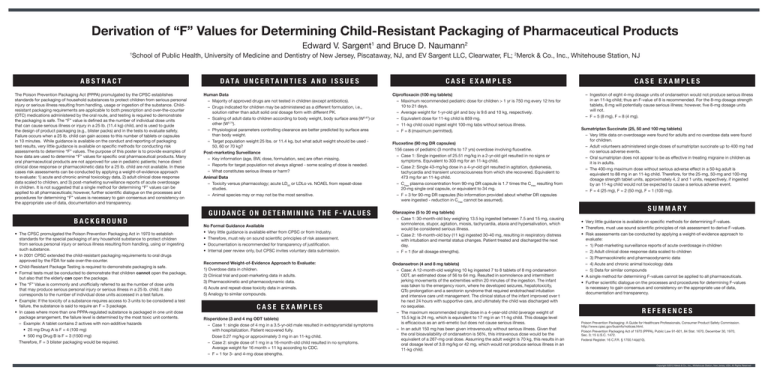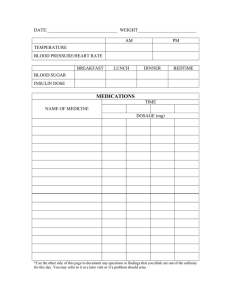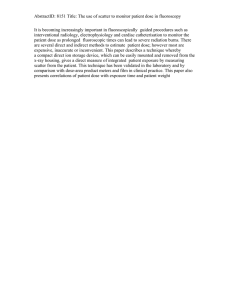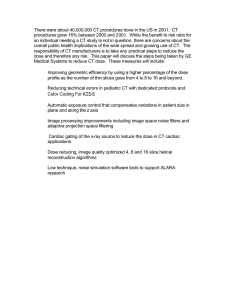
Derivation of “F” Values for Determining Child-Resistant Packaging of Pharmaceutical Products
Edward V. Sargent and Bruce D. Naumann
1
1
2
School of Public Health, University of Medicine and Dentistry of New Jersey, Piscataway, NJ, and EV Sargent LLC, Clearwater, FL; Merck & Co., Inc., Whitehouse Station, NJ
2
ABSTRACT
DATA U N C E RTA I N T I E S A N D I S S U E S
The Poison Prevention Packaging Act (PPPA) promulgated by the CPSC establishes
standards for packaging of household substances to protect children from serious personal
injury or serious illness resulting from handling, usage or ingestion of the substance. Childresistant packaging requirements are applicable to both prescription and over-the-counter
(OTC) medications administered by the oral route, and testing is required to demonstrate
the packaging is safe. The “F” value is defined as the number of individual dose units
that can cause serious illness or injury in a 25 lb. (11.4 kg) child, and is used to guide
the design of product packaging (e.g., blister packs) and in the tests to evaluate safety.
Failure occurs when a 25 lb. child can gain access to this number of tablets or capsules
in 10 minutes. While guidance is available on the conduct and reporting of packaging
test results, very little guidance is available on specific methods for conducting risk
assessments to determine “F” values. The purpose of this poster is to provide examples of
how data are used to determine “F” values for specific oral pharmaceutical products. Many
oral pharmaceutical products are not approved for use in pediatric patients; hence direct
clinical dose response or pharmacokinetic data for a 25 lb. child are not available. In these
cases risk assessments can be conducted by applying a weight-of-evidence approach
to evaluate: 1) acute and chronic animal toxicology data, 2) adult clinical dose response
data scaled to children, and 3) post-marketing surveillance reports of acute overdosage
in children. It is not suggested that a single method for determining “F” values can be
applied to all pharmaceuticals; however, further scientific dialogue on the processes and
procedures for determining “F” values is necessary to gain consensus and consistency on
the appropriate use of data, documentation and transparency.
Human Data
– Majority of approved drugs are not tested in children (except antibiotics).
– Drugs indicated for children may be administered as a different formulation, i.e.,
solution rather than adult solid oral dosage form with different PK.
– Scaling of adult data to children according to body weight, body surface area (W0.67) or
other (W0.75).
– Physiological parameters controlling clearance are better predicted by surface area
than body weight.
– Target population weight 25 lbs. or 11.4 kg, but what adult weight should be used 50, 60 or 70 kg?
Post-marketing Surveillance
– Key information (age, BW, dose, formulation, sex) are often missing.
– Reports for target population not always aligned - some scaling of dose is needed.
– What constitutes serious illness or harm?
Animal Data
– Toxicity versus pharmacology; acute LD50 or LDLo vs. NOAEL from repeat-dose
studies.
– Animal species may or may not be the most sensitive.
BACKGROUND
• T
he CPSC promulgated the Poison Prevention Packaging Act in 1970 to establish
standards for the special packaging of any household substance to protect children
from serious personal injury or serious illness resulting from handling, using or ingesting
such substance.
• In 2001 CPSC extended the child-resistant packaging requirements to oral drugs
approved by the FDA for sale over-the-counter.
• C
hild-Resistant Package Testing is required to demonstrate packaging is safe.
• F
ormal tests must be conducted to demonstrate that children cannot open the package,
but also that the elderly can open the package.
• T
he “F” Value is commonly and unofficially referred to as the number of dose units
that may produce serious personal injury or serious illness in a 25 lb. child. It also
corresponds to the number of individual dose units accessed in a test failure.
• E
xample: If the toxicity of a substance requires access to 3 units to be considered a test
failure, the substance is said to require an F = 3 package.
• In cases where more than one PPPA-regulated substance is packaged in one unit dose
package arrangement, the failure level is determined by the most toxic unit contents.
– E
xample: A tablet contains 2 actives with non-additive hazards
• 25 mg Drug A is F = 4 (100 mg)
• 500 mg Drug B is F = 3 (1500 mg)
Therefore, F = 3 blister packaging would be required.
G U I DA N C E O N D E T E R M I N I N G T H E F - VA L U E S
No Formal Guidance Available
• Very little guidance is available either from CPSC or from Industry.
• Therefore, must rely on sound scientific principles of risk assessment.
• Documentation is recommended for transparency of justification.
• Internal peer review only, but CPSC invites voluntary data submission.
Recommend Weight-of-Evidence Approach to Evaluate:
1) Overdose data in children.
2) Clinical trial and post-marketing data in adults.
3) Pharmacokinetic and pharmacodynamic data.
4) Acute and repeat-dose toxicity data in animals.
5) Analogy to similar compounds.
CASE EXAMPLES
Risperidone (3 and 4 mg ODT tablets)
– Case 1: single dose of 4 mg in a 3.5-yr-old male resulted in extrapyramidal symptoms
with hospitalization. Patient recovered fully.
Dose 0.27 mg/kg or approximately 3 mg in an 11-kg child.
– Case 2: single dose of 1 mg in a 16-month-old child resulted in no symptoms.
Average weight for 16 month = 11 kg according to CDC.
– F = 1 for 3- and 4-mg dose strengths.
CASE EXAMPLES
Ciprofloxacin (100 mg tablets)
– Maximum recommended pediatric dose for children > 1 yr is 750 mg every 12 hrs for
10 to 21 days.
– Average weight for 1-yr-old girl and boy is 9.6 and 10 kg, respectively.
– Equivalent dose for 11-kg child is 859 mg.
– 11-kg child could ingest eight 100-mg tabs without serious illness.
– F = 8 (maximum permitted).
Fluoxetine (90 mg DR capsules)
156 cases of pediatric (3 months to 17 yrs) overdose involving fluoxetine.
– Case 1: Single ingestion of 25.51 mg/kg in a 2-yr-old girl resulted in no signs or
symptoms. Equivalent to 303 mg for an 11-kg child.
– Case 2: Single 43-mg/kg dose in a 4-yr-old girl resulted in agitation, dyskenesia,
tachycardia and transient unconsciousness from which she recovered. Equivalent to
473 mg for an 11-kg child.
– Cmax plasma concentration from 90-mg DR capsule is 1.7 times the Cmax resulting from
20-mg single oral capsule, or equivalent to 34 mg.
– F = 3 for 90-mg DR capsules (No information provided about whether DR capsules
were ingested - reduction in Cmax cannot be assumed).
Olanzapine (5 to 20 mg tablets)
– Case 1: 30-month-old boy weighing 13.5 kg ingested between 7.5 and 15 mg, causing
somnolence, stupor, agitation, miosis, tachycardia, ataxia and hypersalivation, which
would be considered serious illness.
– Case 2: 18-month-old boy (11 kg) ingested 30-40 mg, resulting in respiratory distress
with intubation and mental status changes. Patient treated and discharged the next
day.
– F = 1 (for all dosage strengths).
Ondansetron (4 and 8 mg tablets)
– Case: A 12-month-old weighing 10 kg ingested 7 to 8 tablets of 8 mg ondansetron
ODT, an estimated dose of 56 to 64 mg. Resulted in somnolence and intermittent
jerking movements of the extremities within 20 minutes of the ingestion. The infant
was taken to the emergency room, where he developed seizures, hepatotoxicity,
QTc prolongation and a serotonin syndrome that required endotracheal intubation
and intensive care unit management. The clinical status of the infant improved over t
he next 24 hours with supportive care, and ultimately the child was discharged with
no sequelae.
– The maximum recommended single dose in a 4-year-old child (average weight of
15.5 kg) is 24 mg, which is equivalent to 17 mg in an 11-kg child. This dosage level
is efficacious as an anti-emetic but does not cause serious illness.
– In an adult 150 mg has been given intravenously without serious illness. Given that
the oral bioavailability of ondansetron is 56%, this intravenous dose would be the
equivalent of a 267-mg oral dose. Assuming the adult weight is 70 kg, this results in an
oral dosage level of 3.8 mg/kg or 42 mg, which would not produce serious illness in an
11-kg child.
CASE EXAMPLES
– Ingestion of eight 4-mg dosage units of ondansetron would not produce serious illness
in an 11-kg child; thus an F-value of 8 is recommended. For the 8-mg dosage strength
tablets, 8 mg will potentially cause serious illness; however, five 8-mg dosage units
will not.
– F = 5 (8 mg), F = 8 (4 mg).
Sumatriptan Succinate (25, 50 and 100 mg tablets)
– Very little data on overdosage were found for adults and no overdose data were found
for children.
– Adult volunteers administered single doses of sumatriptan succinate up to 400 mg had
no serious adverse events.
– Oral sumatriptan does not appear to be as effective in treating migraine in children as
it is in adults.
– The 400-mg maximum dose without serious adverse effect in a 50-kg adult is
equivalent to 88 mg in an 11-kg child. Therefore, for the 25-mg, 50-mg and 100-mg
dosage strength tablet units, approximately 4, 2 and 1 units, respectively, if ingested
by an 11-kg child would not be expected to cause a serious adverse event.
– F = 4 (25 mg), F = 2 (50 mg), F = 1 (100 mg).
SUMMARY
• Very little guidance is available on specific methods for determining F-values.
• Therefore, must use sound scientific principles of risk assessment to derive F-values.
• Risk assessments can be conducted by applying a weight-of-evidence approach to
evaluate:
– 1) Post-marketing surveillance reports of acute overdosage in children
– 2) Adult clinical dose response data scaled to children
– 3) Pharmacokinetic and pharmacodynamic data
– 4) Acute and chronic animal toxicology data
– 5) Data for similar compounds
• A single method for determining F-values cannot be applied to all pharmaceuticals.
• Further scientific dialogue on the processes and procedures for determining F-values
is necessary to gain consensus and consistency on the appropriate use of data,
documentation and transparency.
REFERENCES
Poison Prevention Packaging: A Guide for Healthcare Professionals, Consumer Product Safety Commission.
http://www.cpsc.gov/businfo/notices.html.
Poison Prevention Packaging Act of 1970 (PPPA), Public Law 91-601, 84 Stat. 1670, December 30, 1970,
Sec. 3; 15 U.S.C. 1472.
Federal Register. 16 C.F.R. § 1700.14(a)(10).
Copyright ©2012 Merck & Co., Inc., Whitehouse Station, New Jersey, USA, All Rights Reserved



